Are you a beginning guitar player, or has it been quite some time since you’ve had a go at it and are picking up your instrument again? If your fingertips hurt playing guitar, then I’ve got you covered!
This article will share my tips and tricks to stop the pain and get going on the guitar. Don’t let sore fingers stop you from achieving your goals and having all the fun you’re missing!
Keep on reading to learn more.
“Why Do My Fingertips Hurt When I Play Guitar?”
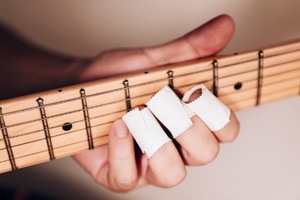
Your fingertips have a high concentration of nerve endings to help you feel things like the temperature and texture of things you touch. However, the constant action of putting pressure on your skin by pressing down on a guitar’s strings eventually inflames those nerves.
Some players call this painful condition “guitar finger.” Fingertip pain that wasn’t present before you started playing the guitar is usually nothing to be concerned about, as long as it goes away between sessions and there are no signs of serious skin damage.
If you become concerned about pain in your fingers or hands, the best thing to do is call your healthcare provider.
Your Body To The Rescue – What Are Guitar Calluses?
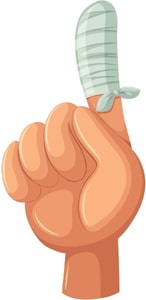
As a protective mechanism, your fingers produce additional cells that thicken your skin in this area to form a callus, which is essentially an extra layer of dead skin that feels no pain.
Most people are familiar to some extent with calluses on their hands or feet. Although we try to remove unsightly calluses, guitar players need them at their fingertips to play effectively. Don’t worry; most people will never even notice them.
How To Build Calluses On Fingers For Guitar
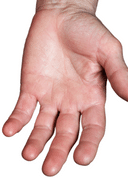
The best way to build calluses on your fingertips is to keep on playing every day. Start by playing slowly and for a short period of time.
As your fingertips begin to toughen up, you can add more and more time to your practice schedule. Before you know it, you will be playing for an hour or more without any finger discomfort.
When I first started playing guitar, I was so excited that I found it practically impossible to put it down for long periods of time. However, later on, I realized that I would have made better progress in the first one or two months if I had given my fingers a chance to rest.
Keeping Your Learning Experience Positive

If you are just beginning to play guitar, it’s important to keep the learning experience positive. It’s easy to become discouraged and overwhelmed with all there is so much to learn. Adding unnecessary finger pain to the mix will just make things worse.
Remember, it’s not a race to the finish line. Are you having fun playing your guitar? Always make this a high priority! After all, it’s probably why you wanted to play the guitar in the first place.
So, learn at your own pace, and don’t be afraid to stop if anything hurts.
Related Article ➡ Why Learn To Play The Guitar? – Read This Before You Decide!
Related Article ➡ Is Playing A Guitar A Talent Or Skill? – Secrets To Success!
Should You Toughen Your Fingertips?
I have seen people do practically everything you can imagine to try to toughen their fingertips when they first start playing the guitar. Common methods include using sandpaper to roughen the skin, alcohol to dry the skin out, pressing on their fingertips with the edge of a credit card, and using gadgets that simulate guitar string pressure (see the FAQ section).
I have even seen players use super glue to add extra padding to their fingertips or repair damaged calluses, which I definitely would not recommend. Besides, things like gluing your fingers or wearing a cotton glove while you play will not allow your skin to toughen properly, and you won’t be able to play naturally and properly.
In my opinion, the best approach is to let your fingertips toughen up naturally with slow callus formation. Trying to rush the process will most likely cause you additional and unnecessary discomfort.
Choose Your Guitar Wisely And Set It Up Correctly
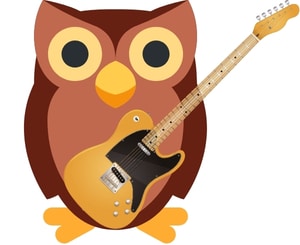
The guitar you learn on can make a big difference in your playing experience, particularly how much fingertip discomfort you experience.
The first guitar I actually picked up was my sister’s nylon-string Gibson. She played folk and country music, so I don’t really know how she ended up buying a classical guitar, but those strings felt pretty good under my fingers.
I planned to go electric, so I messed around with that nylon string until I bought my first Sears Silvertone guitar and amp. By then, my fingertips were already in pretty good shape, so the transition to steel strings was fairly easy.
Your Starting Guitar Is A Key Consideration
Many people trying learning on an instrument that even an advanced guitarist would find difficult to play. It is often a hand-me-down, previously used by someone like their great uncle or a guitar picked up at a flea market that looks like it a real finger-masher.
This may or may not work out, depending on the guitar and your desire to learn. Jimi Hendrix started playing on an old broomstick, and the rest is history!
Still, there are some things you can do to make things easier on your fingers.
- Ask an experienced player to help you choose your first guitar. Looks can be deceiving. A guitar that looks easy to play could surpirse you after you get started.
- If you plan on playing electric guitar then don’t begin learning on an acoustic. Electrics are typically easier on the fingers. Many acoustic players begin on electrics and then switch after they get comfortable with the learning process.
- Get a “setup” done on your guitar to make it more player-friendly. You can permanently damage your guitar if you don’t have the proper training and experience, so it’s best to bring it to a music store or repair shop.
Three Guitar Tweaks That Can Help Finger Pain
Here are some additional things you can do to make your guitar easier to play.
1. Replace Old Strings
This is the first thing to check if you are finding your guitar difficult to play! Strings that are dirty or worn out can require more tension to tune properly. You also have to press down harder on them to get a clear sound.
I have seen players try to learn on a guitar with “rusty” metal strings. One student didn’t realize that he had the option of replacing his strings with new ones.
For more info, see How To Fix Guitar String Problems – Easy Things You Can Do!
2. Use A Lighter String Gauge
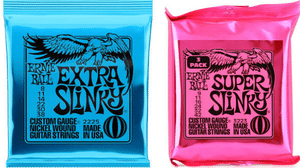
A lighter gauge (thinner) string will be easier to press down, especially at the lower frets (closer to the headstock).
After you change the string gauge, your guitar will probably need a setup to compensate for the difference in string tension.
If you play electric and want to begin “bending” strings or using finger vibrato, a light string gauge will save you a lot of finger discomfort.
I would suggest you begin with “8-gauge” (8, 11, 14, 22, 30 38) or “9-gauge (9, 11, 16, 24, 32, 42) strings.
For acoustic guitar get a good set of “extra light” (10, 14, 20, 28, 40, 50) or “light gauge”strings.
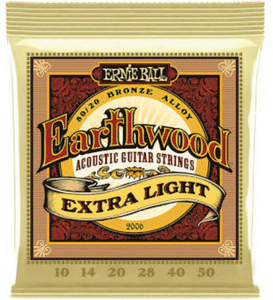
You can always increase the string gauge after your fingers become accustomed to playing on the thinner ones.
Nylon string guitars can be easier to fret for beginning players than steel or bronze strings. However, most people that buy nylon string guitars are acoustic players that want to learn classical music.
For more info, see Guitar String Gauge Guide – Finding Your New Sound!
For players with arthritis of the hands, guitar type and string gauge are important. For more info, see Playing Guitar With Arthritis: Overcoming Your Hand Problems.
3. Lower The String Height (Action)
String “action” is basically how high the strings are off the surface of your frets. A string action that is too high can make it more difficult to press down on the strings so that each note sounds clear, especially if the string gauge is too large.
Electric guitars usually have lower string action and lighter gauge strings than acoustic guitars.
The electric guitar neck in the photo is set up to have fairly low action. You can’t really go too much lower on the E, A, and D strings without creating string buzz when you sound the notes.
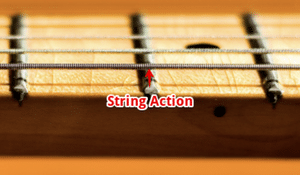
The string height on most acoustic guitars is not easily adjustable.
Never attempt to adjust your guitar if you don’t know how to do it properly. You could permanently damage your guitar.
For more info, see How To Stay Motivated To Learn Guitar – Top Tips For Success.
Finger Placement And Pressure Are Important, Too
It’s also important to place your fingers on the fingerboard where they feel the most comfortable and require the least amount of pressure to make the note sound clearly, especially when you first start playing.
This position is usually as close to the fret in front of the note you are playing. So, if you are playing a note in the 5th position (between the 5th and 6th frets), then place your finger as close to the 6th fret as you can.
Here is a video from Justin Guitar that illustrates this principle. Check it out!
Frequently Asked Questions

Here are some of the questions that I’m often asked about fingertip soreness.
Should I Stop Playing If My Fingers Begin To Hurt?
When your fingers start to become uncomfortably sore, then stop immediately. You don’t want to form a blister on your fingertip, which is very painful and counterproductive. In addition, blister formation can set you back days before you will be able to play again.
Start with a 5 or 10-minute practice session and slowly advance as tolerated. You definitely don’t want to overdo it when you first start playing.
For more info, see Learning Guitar For Seniors – Make Each Day Great With Music.
How Do You Relieve Finger Pain From Guitar Playing?
The best way to get relief is to stop playing immediately. Some players get relief from applying ice to their fingertips. You can also check with your healthcare provider to see if you can take a pain reliever.
Do Guitar Finger Protectors Work?
Although silicone guitar finger protectors help alleviate fingertip discomfort, I don’t recommend them for general use. If you use finger protection, then you will never develop calluses, so you will probably not be able to play effectively without them.

These products can interfere with normal finger mechanics and make it difficult to execute fast or intricate passages.
I have seen players with various medical conditions that affect the fingers, like neuropathy (inflammation of the nerve endings), use finger protectors or a “guitar glove” effectively.
How Long Does It Take To Play Without Finger Pain?
That will vary, depending on the degree of callus formation on your fingertips, your playing style, and the guitar you are playing. Typically it takes from 2 to 4 weeks if you play every day.
Everyone is a little different, so don’t be concerned if it takes a little longer. When your fingertips become fully conditioned you’ll never give it another thought.
When Will Calluses Form On My Fingertips?
Everyone forms calluses at their fingertips at a different rate. The first sign of callus formation will be that your fingertips will feel firmer on your fretting hand compared to your picking hand.
As you continue to play, you will begin to notice visual signs of callus formation. Specifically, the skin on your fingertips will take on a somewhat “rough” texture and may even look “whiter” as dead skin cells begin to thicken the area.
How Can I Make My Guitar Calluses Faster?
Several types of devices can help you build calluses faster at your fingertips by applying mechanical pressure to your skin.
I usually recommend that you simply continue to play guitar every day and build your calluses naturally. This will create them in exactly the areas of your fingertips that come in contact with the strings.
If your use a callus builder like “Perfect Pinch,” then remember not to overdo it. It’s better to use it in short, frequent applications. Stop for a while if your fingertips become too sore.
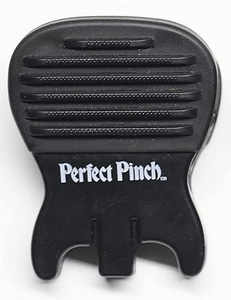
Will I lose My Calluses If I Stop Playing?
If you don’t play your guitar frequently, your calluses will begin to soften and eventually disappear. To keep your calluses in good shape, you should play at least twice a week for a minimum of 15 to 30 minutes a session. The more you play, the more robust your calluses will become.
How Long Do Calluses Take To Heal?
If a piece of a callus comes loose from your fingertip, then it needs to reform in that area. Depending on how much of the callus becomes damaged or comes off, it can reform in a few days or may take a week or two.
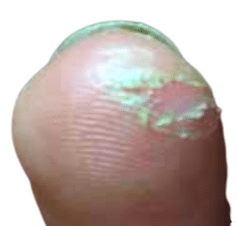
To prevent callus damage, avoid soaking your hands in water for long periods of time. If you have your hands in water frequently, then use rubber gloves to keep them dry.
Also, avoid putting skin lotion or rehydrating agents on your fingertips.
Will Playing The Guitar Permanently Damage My Fingers?
If you don’t have any medical problems affecting your hands, playing the guitar using the proper technique will not cause permanent finger damage.
The best policy is to stop playing and rest your hands and fingers if they begin to hurt or bother you in any way. After adequate callus formation, you usually only need a short break before you can resume playing.
What Else Can Cause Pain In My Hand And Fingers?
Medical conditions that affect your hands aside, playing with poor posture and bad technique are the most common causes of pain in your hands and fingers. Therefore, it’s important to learn how to play properly early on.
If you think you are doing something wrong, it’s a good idea to take a few guitar lessons to get it sorted out. There are also a lot of online resources that can help you made the appropriate corrections.
What Is Guitar Tendonitis?
“Guitar tendinitis,” as many players call it, is a medical condition where the tendons (structures that attach muscle to bone) in your hand and fingers become inflamed.
This can happen if you play guitar excessively or are a very fast player (“shredder”), especially if you have an instrument that is difficult to play.
It’s always good to start with some warm-up exercises, especially if you are learning a difficult piece of music. Remember to start slowly and work your way up to tempo. The best way to play fast with accuracy and precision is to practice slow.
If you think you are developing tendinitis, then stop playing and contact your healthcare provider for further instructions.
What Is Carpal Tunnel Syndrome?
Carpal tunnel syndrome is a medical condition that comes from compressing and inflaming a nerve in your wrist (the median nerve). It is commonly seen in people who frequently use their hands for repetitive tasks like typing on a keyboard or playing an instrument.
Carpal tunnel syndrome can cause abnormal sensations or discomfort in your fingers. If you think you have carpal tunnel syndrome, then stop playing and check with your healthcare provider.
Final Thoughts On Guitar Finger Pain

As with most stringed instruments, learning to play the guitar can be a bit of a painful experience, especially in the early stages. So it’s important not to overdo it when you are first starting.
Begin with a 5 or 10-minute practice session and gradually increase the time. Stop immediately if your fingers become uncomfortably sore. Give your fingertips time to form protective calluses.
After 1 or 2 weeks, it should start to get easier to play, and you should begin to notice the skin on your fingertips getting tougher. Once you reach this point then it’s “all downhill” from here!
Learning on a guitar that is easy to play will make things less painful. Guitars with very thick strings that are too high above the frets can cause a lot of finger discomfort in beginners. An electric guitar with thin-gauge strings that can be adjusted to be close to the frets (low action) is a good choice.
Many students give up during the first few uncomfortable weeks of learning to play the guitar. Be persistent, practice smart, and don’t get discouraged. It’s important to realize that the initial finger discomfort is a temporary situation.
The guitar is an instrument that can provide you with a lifetime of entertainment and pleasure. Please don’t allow sore fingertips from the guitar to discourage you from making progress. So stick with it, and you will be glad you did!
Related Article ➡ Build Finger Strength For Guitar – Play It Like You Mean It!
Related Article ➡ Do Guitar Gloves Work? – Are They Better Than Bare Fingers?
Tell Me What You Think

Please let me know what’s on your mind in the comment section or if I can help you with anything?
- Are you having sore fingers from guitar playing?
- What are you currently doing/using for guitar finger pain relief?
- Have you ever had a serious guitar finger injury?
- Any advice for beginning musicians to help minimize “guitar players fingers?”
- How long did it take you to develop fingertip calluses? How do you keep them in good condition?




This was a great article for new guitarists and it has lots of great advice. I think every guitarist has had sore fingers at one time or another. I’ve been playing for over 40 years but recently I just hadn’t been playing for weeks, I had noticed most of my callouses were disappearing.
So I wasn’t surprised when I played with a friend last week that my fingers started hurting. We had been jamming for about an hour so I suggested we stop. My fingers were throbbing for about half an hour and then stopped after I applied some ice. The next day I played again for about 30 minutes with no problem. I’m now playing for about 20 minutes a day to get those callouses back before gig time starts again.
Thanks for the great advice.
Hi. Lily
Thanks for your comments!
As you know, it doesn’t take long to decondition your finger calluses. Luckily, I very seldom miss a day of playing the guitar, maybe 1-2 times a year, or not at all. I have guitars strategically located everywhere that you can imagine, although most of them are in my music room.
It’s unusual for me to play less than 3 or 4 hours a day, and I do whatever it takes to make it happen. I break up the time into 2-3 sessions to fit into whatever else is happening for the day, primarily working and spending time with my wife.
Depending on how they are set up, I have 0.09 or 0.10 gauge strings on all my electric guitars. If I want to toughen my calluses, then I usually play acoustic guitar for several days continuously.
Frank
When I was younger I took up the guitar and developed very impressive guitar callouses and could play for a long time without any pain. Then I didn’t play for like a decade and then decided to pick it up again and OMG I had forgotten the pain accompanies building up my callouses again. I was hoping that you had a super-secret way to avoid the pain altogether, but no such luck LOL, it just takes work and dedication to practice every day. The fingers will toughen up.
Hi, Al
Thank You for your comments!
It is a bit of a slow process to build guitar calluses. Unfortunately, there is no “super-secret” way to avoid the pain altogether, but many of the things I outlined in this article can really help.
I have found that if you start slow, using an electric guitar with very thin-gauge strings and low action, the discomfort will be minimal. Slowly increase your practice time as your calluses begin to form.
Playing 2 or 3 times a week for just 20 or 30 minutes each time should keep your calluses in reasonably decent shape.
Keep On Playing!
Frank
Hi, lots of great info here especially for the newer players looking to get going safely for their finger health.
However, I’ve been playing for about 10 years.
I play bass and all my bases have D’Addario Half wound strings which suit my style of play, comfort and most importantly serve the genre I play most!
I also play acoustic 6 and 12 string guitars in a solo and duet act and it’s on the acoustics that I suffer most, but that’s not to say I go pain free on bass. It’s just not nearly as frequent.
What I experience is a near pin point pain that feels as if I punctured my finger tip with the very end of a .009 gage high E string and it originated at the tip of the bone and incapacitates my left hand ring finger!
This is the only ginger that has ever suffered this sort of pain and lasting discomfort.
When it happens during a gig, I often want to just quit for the night, but that will happen only once and I’ll never play again if ever I did do that!
Anyway, I wonder has anyone suffered the same chronic ailment and corrected it? If so, would you ease share with me and possibly other sufferers, just how you overcame the problem and put an end to it?
Thank you all for your attention andmay God keep us all in His safe and loving hands! ✌️
Hi, There
I used D’Addario Half Wounds when I played Jazz; they sound and feel great!
For your finger pain, try a pair of guitar gloves. They are made from thin nylon, and I know a few players that find them helpful for treating finger soreness. You can get them on Amazon for less than $20.
I hope this helps you with your problem!
Happy Holidays!
Frank ? ?